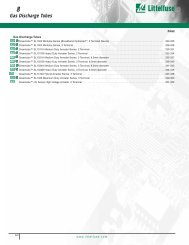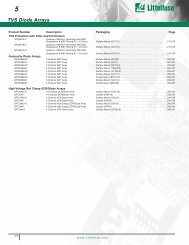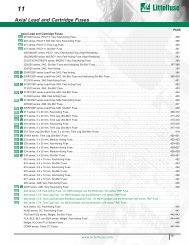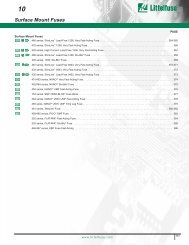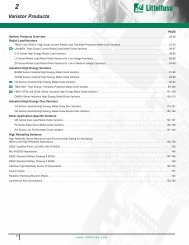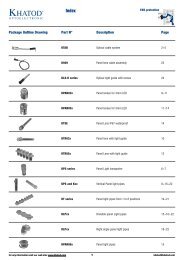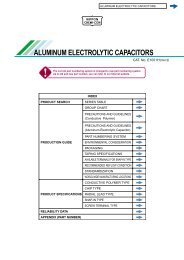Introduction to Circuit Protection
Introduction to Circuit Protection
Introduction to Circuit Protection
Create successful ePaper yourself
Turn your PDF publications into a flip-book with our unique Google optimized e-Paper software.
<strong>Introduction</strong> <strong>to</strong> <strong>Circuit</strong> <strong>Protection</strong><br />
Transien<strong>to</strong>logy<br />
Overvoltage Suppression Facts<br />
The considerations below restate how the product attributes/offerings<br />
can differ as an aid in determining which device family may be<br />
most appropriate.<br />
When <strong>to</strong> choose the Silicon <strong>Protection</strong><br />
• The device being protected requires the lowest possible clamp voltage<br />
(9.2), low capacitance (3 <strong>to</strong> 40pF) and low leakage (5nA <strong>to</strong> 10uA).<br />
• Board space is at a premium and space-savings multi-line protection is<br />
needed.<br />
• Additional features such as EMI and termination are required.<br />
• Transients are ESD or beyond such as EFT or Lightning.<br />
When <strong>to</strong> choose the PulseGuard ® Suppressors<br />
• The application cannot <strong>to</strong>lerate added capacitance (high speed<br />
data lines or RF circuits)<br />
• ESD is the only transient threat<br />
• On data, signal, and control lines (not power supply lines)<br />
• The suppression function must be within a Dsub connec<strong>to</strong>r<br />
(PGD types)<br />
When <strong>to</strong> choose the ML, MLE or MLN Series<br />
• Surge currents or energy beyond ESD is expected in the application<br />
(EFT, Lightning remnants).<br />
• Replacing high wattage TVS Zeners (300-1500W).<br />
• Added capacitance is desirable for EMI filtering (3pF - 6000pF).<br />
• Power supply line or low/medium speed data, signal lines are <strong>to</strong><br />
be protected.<br />
• Single, leadless SM package is required<br />
• The operating voltage is above the SP or PulseGuard ®<br />
Suppressor ratings.<br />
Conclusion<br />
Choosing the most appropriate suppressor depends upon a balance<br />
between the application, its operation, voltage transient threats expected<br />
and sensitivity levels of the components requiring protection. Form<br />
fac<strong>to</strong>r/package style also must be considered.<br />
The three Littelfuse technologies described offer a comprehensive choice<br />
for the designer. Reviewing the attributes of each can result in a suitable<br />
ESD suppression solution for most applications. See the individual data<br />
sheets for specific electrical and mechanical information.<br />
16<br />
www.littelfuse.com<br />
SIDAC<strong>to</strong>r ® Devices<br />
Available in surface mount, axial leaded and TO-220 through hole package<br />
options. Offers protection from medium <strong>to</strong> hight energy transients.<br />
SIDAC<strong>to</strong>r ® thyris<strong>to</strong>rs are specifically designed for transient suppression in<br />
telecom and data transmission systems.<br />
Silicon Avalanche Diodes (SADs)<br />
The Transient Voltage Suppressor diode (T.V.S.) is specifically designed<br />
<strong>to</strong> protect electronic circuits against transients and over voltages. It is a<br />
silicon avalanche device available in both uni-directional and bi-directional<br />
configurations. With a uni-directional, the specified clamping characteristic<br />
is only apparent in one direction, the other direction exhibiting a V F<br />
normally experienced with conventional rectifier diodes. All electrical<br />
characteristics are specified at 25˚C.<br />
When selecting a TVS device there are some important parameters <strong>to</strong> be<br />
considered, including; Reverse Standoff Voltage (VR), Peak Pulse Current<br />
(IPP) and Maximum Clamping Voltage (VC max).<br />
The most important is VR, this is the parameter that is the key <strong>to</strong> selecting<br />
a TVS diode. The VR of the device should be equal <strong>to</strong>, or greater<br />
than, the peak operating level of the circuit <strong>to</strong> be protected. This will<br />
ensure that the TVS diode does not clip the circuit drive voltage.<br />
The Peak Pulse Current (IPP) is the maximum current the TVS diode can<br />
withstand without damage. The required IPP can only be determined by<br />
dividing the peak transient voltage by the source impedance. Of course,<br />
in many cases, the very nature of transient occurance makes this parameter<br />
difficult <strong>to</strong> determine. The TVS diode failure mechanism is a short<br />
circuit, therefore if the device fails due <strong>to</strong> a transient, the circuit will still<br />
be protected.<br />
In secondary protection applications, any series impedances due <strong>to</strong><br />
resis<strong>to</strong>rs, transformers and induc<strong>to</strong>rs will have a limiting effect on the<br />
peak pulse current. In some cases these may be due <strong>to</strong> long lengths of<br />
interconnecting wire.<br />
The Maximum Clamping Voltage (VC max) is the peak voltage that will<br />
appear across the TVS device when subjected <strong>to</strong> the Peak Pulse Current<br />
(IPP), based on a 1ms exponential waveform. This waveform is a 10 /1000<br />
microsecond waveform as shown in Figure 9.<br />
This pulse is a standard test waveform used for protection devices.<br />
CURRENT<br />
IPP<br />
0.9 IPP<br />
0.5 IPP<br />
0.1 IPP<br />
PEAK VALUE<br />
T= 10µS<br />
1000µS<br />
TIME<br />
Figure 9. 10x1000µs test waveform




